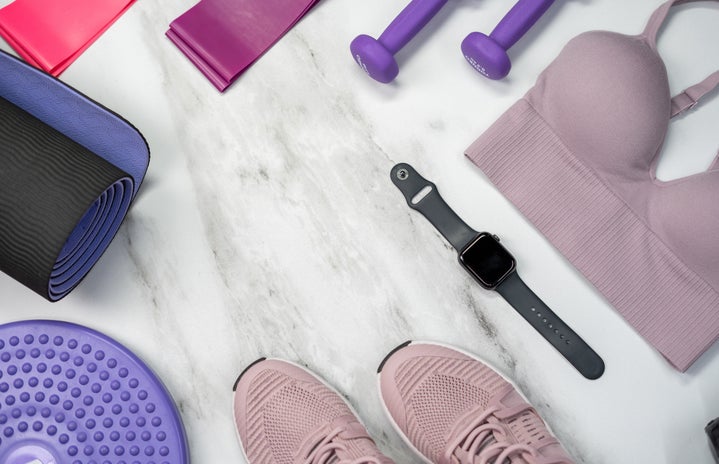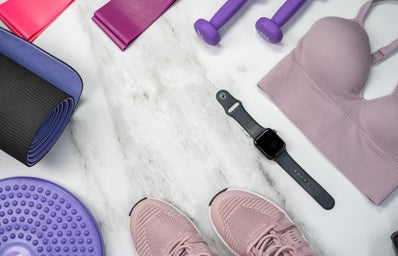Let’s face it: we’re all guilty of trying to do something productive, only to be deterred by seemingly small inconveniences along the way. Working out is no exception, with its own set of physical and mental barriers. But hey, when there’s a will, there’s a way! Here are some common concerns that might be holding you back from exercising, and some advice on how to overcome them:
- Big boobs
-
One of the downsides to having larger breasts is that exercising can cause a lot of pain, as vigorous movements tend to create a high impact on the chest. You might also be feeling embarrassed or self-conscious — as if exercising isn’t tough enough already!
But fret not, there are heaps of ways to work around this problem. For a start, it’s very important to find a fitted sports bra that gives you good support, especially during higher-impact activities such as running or jumping. Most sportswear brands will indicate the level of support of their bras, but a good rule of thumb is that the thicker the strap, the higher the support.
You might also want to adopt lower-impact workouts. Mind you, lower impact doesn’t mean lower intensity. Resistance training, such as with weights or elastic bands, can effectively work the muscles even as you remain in a relatively static position. This includes all kinds of squats, deadlifts and presses. If you don’t want to use weights, you can also try band workouts. In essence, resistance training forces your muscles to contract against an external force, which achieves the goal of exercise without you having to jump around too much and hurt your boobs.
It’s also worthwhile to check out yoga, which generally involves gentler movements. And because yoga classes are usually a female-dominant environment, you may feel more at ease when exercising.
But while it’s tempting to skip cardiovascular activities that require more jumping and are high impact, like running, you shouldn’t exclude them completely as they’re still important for your health. Rather, try lower impact cardio like cycling, swimming, or even roller-blading! Keep an open mind, and you’ll be surprised at the variety of boob-friendly workouts you can enjoy.
- Small hands
-
If your genes have endowed you with petite fingers, it could be more challenging to perform exercises that require a strong hand grip, like pull-ups or rows.
One solution to this problem is to use wrist straps, which are pieces of fabric that secure your wrist to a bar or heavy weights, to make it easier to hold on to them. Both professional athletes and casual gym-goers use wrist straps to help with grip, so that they can focus on the muscles they want to work out, rather than being hindered by strains on the wrist or fingers. But being too reliant on wrist straps may adversely affect the growth of your forearm muscles, and thus your overall strength, so make sure you use them only when necessary.
Another option is to explore other ways to hold weights, for example cupping a dumbbell in both palms, as in a goblet squat or goblet lunge, instead of clutching the dumbbell with one hand. You might even utilise ankle weights, weighted vests or sandbags which are provided in many gyms to create more resistance while sparing you the burden of a heavy grip.
Not too keen on weights? There are many other types of exercises and equipment that are less grip-demanding. For example, instead of using barbells or dumbbells, you can try doing certain movements like a squat or a chest fly with a resistance band, which can still create an effective exertion on your muscles. YouTube channel ACHV PEAK, for example, offers a variety of resistance band workouts that you can follow along.
And not to forget, you can simply exercise with your own bodyweight. Pushups, crunches, planking, high knees… because you don’t have to hold onto anything, you will likely find these workouts just as easy (or just as difficult) as someone with big hands does.
- On your period
-
Given the lethargy and discomfort that usually come with menstruation, exercising during this time might seem like mission impossible. But actually, the menstrual cycle does not significantly affect sports performance. So if you want to stay somewhat active in those few days, know that exercising isn’t undoable.
However, one thing to keep in mind is to take it easy and honour your body’s limits. Some research has shown that during our period, we feel more positive after moderate activities rather than intense ones. Speaking from my own experience, taking a chill walk or doing a little yoga (lighter ones, such as Hatha or Yin yoga), have always made me feel better when I’m on my period.
At the end of the day, each person’s body is different from the other. Some people may continue to exercise during their menstrual cycle, unfazed; some may want to move around just a little, and some prefer to completely rest. Ultimately, you should decide what’s best for yourself. - Expensive gyms
-
Gym memberships can be a luxury that not everybody can afford. It’s totally fine if you don’t want to fork out hundreds of bucks a month just for the gym; there are many alternative ways to get a good workout for free!
Parks, with their fresh air and greenery, are an awesome place to jog in; stairs can provide elevation and challenge your agility, and many open spaces can be used for a session of high-intensity interval training (HIIT) or yoga.
Moreover, COVID-19 lockdowns around the world have led to a proliferation of home workouts on the Internet, all for you to try out and find your favourite. However, keep in mind that some of these workouts are designed by self-proclaimed fitness gurus whose expertise may be questionable. Rather than following those workouts that are at best ineffective (and at worst, harmful to your body), try to find people with more qualifications and experience.
Personally, when it comes to home workouts, I like to stick to classic moves like push-ups, burpees, squats, dips, crunches… which can all be done with minimal or no equipment. You can also utilise the fitness corners around your neighbourhoods; for example, the pull-up bars can be used for a variety of abs exercises.
As much as you need to “stick to a plan” when exercising, your plan should also be flexible enough to adapt to your physical, mental or even financial needs. This is especially so if you’re new to working out, as misinformation leads to common pitfalls among beginners. Creating a safe and comfortable environment is important in keeping you motivated to exercise.
And now, the last step: have fun working out!
Original article idea from Zinc Tan, HerCampus Nanyang Tech.


